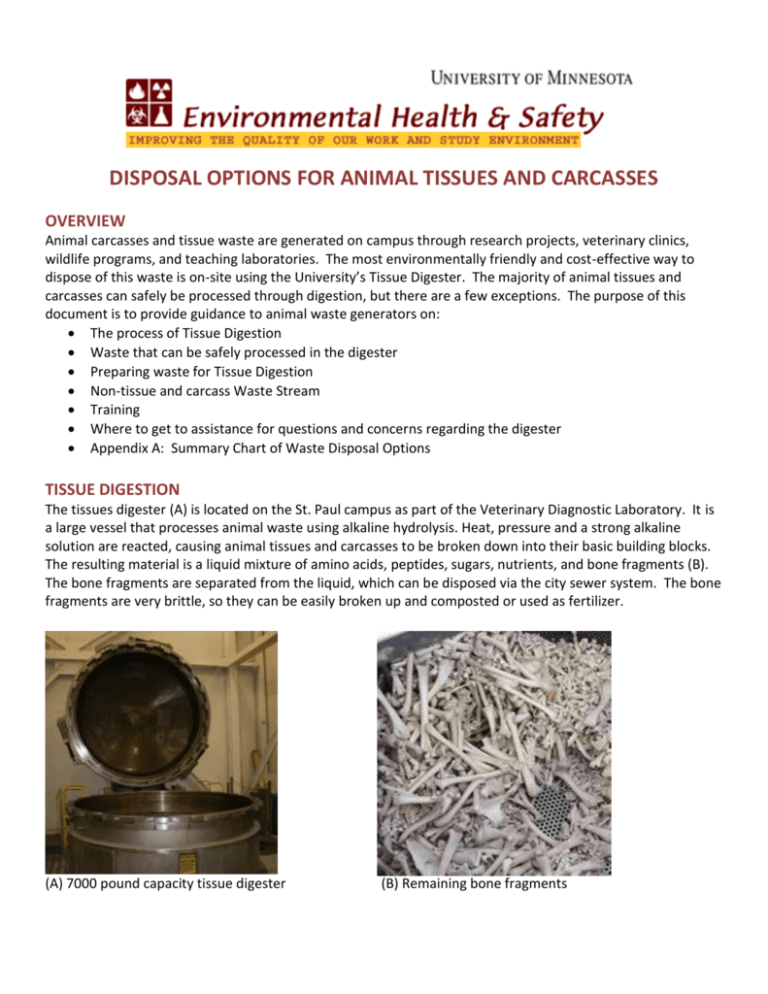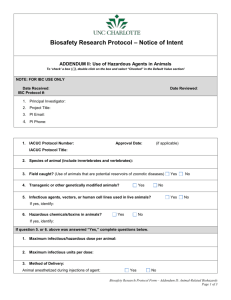Animal Tissue and Carcass Waste Fact Sheet
advertisement

DISPOSAL OPTIONS FOR ANIMAL TISSUES AND CARCASSES OVERVIEW Animal carcasses and tissue waste are generated on campus through research projects, veterinary clinics, wildlife programs, and teaching laboratories. The most environmentally friendly and cost-effective way to dispose of this waste is on-site using the University’s Tissue Digester. The majority of animal tissues and carcasses can safely be processed through digestion, but there are a few exceptions. The purpose of this document is to provide guidance to animal waste generators on: The process of Tissue Digestion Waste that can be safely processed in the digester Preparing waste for Tissue Digestion Non-tissue and carcass Waste Stream Training Where to get to assistance for questions and concerns regarding the digester Appendix A: Summary Chart of Waste Disposal Options TISSUE DIGESTION The tissues digester (A) is located on the St. Paul campus as part of the Veterinary Diagnostic Laboratory. It is a large vessel that processes animal waste using alkaline hydrolysis. Heat, pressure and a strong alkaline solution are reacted, causing animal tissues and carcasses to be broken down into their basic building blocks. The resulting material is a liquid mixture of amino acids, peptides, sugars, nutrients, and bone fragments (B). The bone fragments are separated from the liquid, which can be disposed via the city sewer system. The bone fragments are very brittle, so they can be easily broken up and composted or used as fertilizer. (A) 7000 pound capacity tissue digester (B) Remaining bone fragments WHAT KIND OF WASTE CAN SAFELY BE SENT TO THE DIGESTER? The majority of animal waste can be sent to the digester. Tissue digestion is a sterile process that will effectively inactivate prions and infectious agents. It is important that only animal tissue, carcasses, and pinkcolored digestible bags (C) enter the digester. Plastics, metals, rubber, and other non-tissue materials will clog the pipes that allow the digester to drain. Chemicals should never go into the digester; however, the exception is formalin preserved tissue and carcasses as long as the excess liquid has been collected as hazardous waste to be processed through DEHS. Digestible bags should be collected in designated red bins (D) in Research Animal Resources (RAR) or placed in the designated animal waste coolers. Materials such as ear tags, IVs, tubing, gauze, medical devices and implants should be removed prior to disposal. These materials can be disposed of in the non-tissue biohazardous waste stream (see next section). (C) Digestible bag safe for digestion (D) Red Collection bin for digestible bags Animal carcasses and tissue that contain high hazard chemicals and chemotherapeutic agents must NOT be sent to the digester. Some tissue on campus is preserved by plastination. Plastinated tissue and carcasses can NOT be digested. There will be high hazard yellow waste bags (E) and bins (F) available for animal waste that is not safely digestible. Any carcasses and tissues with implants or medical devices that can’t be removed should go in yellow bags/bin as well. (E) Yellow bags for non-digestible carcasses & tissues containing high hazard agents (F) Collection bin for high hazard carcasses & tissue containing non-digestible agents PREPARING WASTE FOR TISSUE DIGESTION: Small animals and loads 1. Remove any not tissue material from the tissues and carcasses (pads, IVs, medical devices or implants, gauze, tubing, ear tags). Whenever possible, use tattooing or notching as an alternative to ear tags. 2. Place the carcasses and tissue in small digestible bags and tie them closed. Double bag the waste if necessary to prevent leaks and tares. You can purchase the small digestible bags (17 x 16) through UMarket #GC20009. 3. Bring the bags to the nearest red biohazard collection bin or storage cooler. The majority of the animal waste collection bins and coolers are located in RAR. 4. Collection bins will be lined with a large digestible bag provided by Facilities Management (FM). 5. Collection bins must NOT exceed 50 pounds. The large liner bags should be tied off when the bin is ¾ full or at the maximum weight limit. Place the appropriate lid on the bin and tightly seal shut. 6. Red bins will be barcoded so waste can be tracked back to the location where it was collected. This will help FM track locations that have incorrectly handled any waste and give an estimate of how much waste is being generated at each location. Large animals and loads 1. Remove any not tissue material from the carcasses (pads, IVs, medical devices or implants, gauze, staples, tubing, ear tags) 2. Place the carcasses and tissue in large digestible bags and tie them closed. Double bag the waste if necessary to prevent leaks and tares. You can purchase large digestible bags (40 x 46) through UMarket #GC20010 3. In some instances, large animals or loads of waste can be brought directly to the Vet Diagnostics Laboratory for processing. Red carcass bins must NOT exceed 50 pounds or be more than ¾ full under any circumstances and lids need to be closed completely. Please contact Ron Joki at 612-625-0255 for questions regarding large animal preparation for tissue digestion or to arrange a direct drop-off of a large load. DISPOSAL OF NON-DIGESTIBLE ITEMS: NON-TISSUE BIOHAZARD WASTE STREAM Gloves, tubes, padding, gauze and medical devices used in animal procedures should either be autoclaved on site or disposed of in biohazard red bags/gray bins (G). Any needles, metal clips, ear tags or items with sharp edges should go into a biohazardous sharps bin. Materials that contain trace amounts of high hazard chemicals, chemotherapeutic agents or prions, animal bedding and waste must be disposed in the yellow/high hazard waste stream (H). (G) Non-digester biohazard waste stream (H) High hazard items & carcasses waste stream HUMAN TISSUE Human tissue must NOT go into the tissue digester. Contact the University’s Anatomy Bequest Program for questions regarding human tissue, organs, or body parts. TRAINING Anyone that will be generating or handling animal tissues and carcasses on campus, must have special training on how to prepare waste for the Tissue Digester. Most of these trainings will be provided through Research Animal Resources. Please contact your RAR Supervisor if you need training. RAR may not be affiliated with diagnostic, veterinary, or wild life facilities. If you work in one of these areas, please take online Biological and Infectious Waste training through DEHS. If you have questions regarding training, contact DEHS at 612-6266002 or dehs@umn.edu. QUESTIONS OR CONCERNS Contact the RAR Supervisor for your area with any questions regarding animal tissue and carcass waste. Contact DEHS: dehs@umn.edu or 612-626-6002 for questions regarding: For injury accidents or large spills (>100 mls) call 911 Small spills (<100 mls), leaks, or incidents involving biohazardous or tissue digester waste Training questions, if you’re not affiliated with RAR Disposal methods or waste preparation for tissue digestion To report any improperly handled waste (i.e., non-digestible material observed in bags or bins more than 50 pounds. Contact Waste Recovery Services at 612-625-6481 for: Questions regarding bin delivery or pickup Making special collection arrangements If you need additional Red or Yellow bins To order digestible bags contact UMarket Small digestible bags (17 x 16) #GC20009 Large digestible bags (40 x 46) #GC20010 For other questions contact: digester@umn.edu APPENDIX A: SUMMARY TABLES OF ANIMAL WASTE DISPOSAL OPTIONS ANIMAL TISSUE AND CARCASSES TISSUE DIGESTER WASTE OK NO Digestible bags containing animal: Carcasses Organs Tissues Blood Formalin Fixed Tissue Carcasses or Tissue containing prion disease Plastic (tubing, gloves) Paper (wipes, towels) Metal, clips, sharps, glass Plastinated tissue/carcasses Tissue or carcasses that contain Chemotherapy Agents or High hazard chemicals Tissue or carcasses with unrecoverable medical devices or implants WASTE CONTAINING TRACE AMOUNTS OF CHEMOTHERAPY AGENTS OR HIGH HAZARD CHEMICALS YELLOW BAGS/SHARPS CONTAINERS/BINS FOR INCINERATION OK NO Waste containing Chemotherapy agents/high hazard chemicals Carcasses, tissues and organs Carcasses and tissues with unrecoverable medical devices or implants Pads, gloves, bedding Any waste items containing trace amounts of high hazard chemicals, chemotherapy agents or prions Metal clips, ear tags, needles (sharps containers only) Pourable liquid chemicals of any kind (contact DEHS for liquid chemical waste processing) BIOHAZARDOUS NON-TISSUE WASTE FOR OFF-SITE PROCESSING RED BAGS/SHARPS CONTAINERS/GRAY BINS FOR OFFSITE AUTOCLAVING OK NO Non-Tissue/Carcass Biohazard Waste Pads, gauze, tissue, plastic, paper Disposable PPE including gloves, gowns, masks, etc. Metal clips, ear tags, needles (sharps containers only) Any non-tissue potentially infectious waste Animal tissue, organs, carcasses Prion waste of any kind Chemical waste or materials containing chemical residue For information regarding on-site Autoclaving of non-tissue/carcass biohazardous waste, visit the DEHS website.








